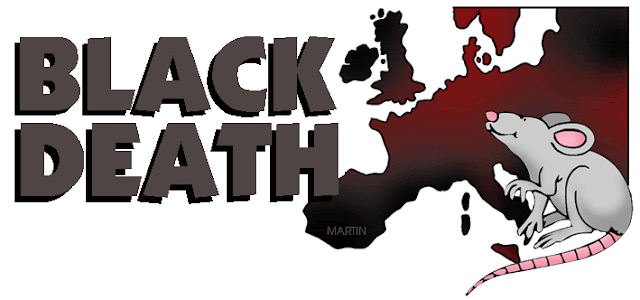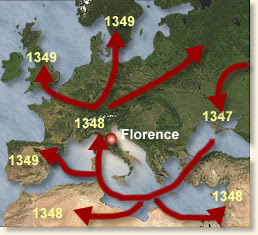In the 14th century, a deadly epidemic
swept across the world. The Black Death, as it became known, was bubonic
plague, a terrible disease that begins with fever, causes agonizing black
dwellings in the glands, and finally leads to death, usually within a few days of
infection. Millions of people died. Terrified people fled infected areas and
carried the plague with them. In towns the doors of plague carriers were marked
with crosses to warn others to keep away. The dead were collected in carts and
buried in mass graves. In Europe about one-third of the population died; a
similar number probably died in Asia.

Burying in mass graves
Progress of the plague

The Plague reached the Black Sea from Asia in 1346.
From there, it was carried by Italian traders to ports on the Mediterranean. It
then spread up rivers and land routes into northern Europe. By 1350, most of
Europe was infected.
Some areas, such as Poland and Milan, escaped the
Plague, but the reason for this is still a mystery.
Disease Carriers
 | ||
| The Plague Cycle |
Plague is caused by a bacterium that lives on rodents.
The disease was caught by black rats in Asia, which then colonized ships to
Europe and spread the disease among people there. An infected person could also
pass the plague through the air, by coughing.
Plague bacterium: The bacterium is also called
Yersinia pestis, after the Swiss biologist Alexander Yersin, who discovered it.
It is common in wild animals such as field mice, marmots and ground squirrels.
Flea carriers: The plague bacterium lives in the
digestive system of a flea, and causes a blockage there. When the flea feeds,
the blockage makes it vomit the newly eaten blood back onto its host, along
with plague bacteria, which then infects the host.
Animal carriers: The black rats lived in towns
and on ships and scavenged in food stores and rubbish heaps. Rats carry fleas,
and when plague-carrying rats died of the disease, their fleas searched for
other hosts. If these new hosts were people, they, too, caught the plague.
Human carriers: The plague turned into an epidemic
so rapidly because human travellers helped spread it. Mongol nomads and Asian
merchants carried it across Asia. The traders of the great Italian cities, such
as Genoa and Venice, carried it around Europe in their ships.
Effects of the Plague
The disease was so widespread that many left
their families took to the road to try to escape death. Some thought the plague
was God’s punishment for the sins of the people, and mercilessly whipped
themselves in the streets to show repentance.
 |
| Whipping to show repentance |
Labour: By the end of the 14th century,
the smaller population of Europe meant that life was better for those who had
survived. Because there were fewer peasants, they got higher wages and there
was more food to go around. But recurring peasant rebellions showed that they
still had grievances.
Chantries: People often left money for masses to be
said for their souls. These masses were said in special chapels inside churches
known as chantries. This chantry is at Winchester, England.
Population Decline: When Pope Clement VI asked
how many people had died from the plague, he was told at least 20 million
people in Europe, and 18 million in Asia. In comparison, around 8 million
soldiers died in World War I.
Tombs: During the plague, people faced death
every day. Death is often realistically shown on 14th-century tombs,
where images of skeletons of decaying corpses are common.
Dealing with the plague
Some people tried to fend off the plague by using
herbal remedies, fumigation, bleeding by leeches, and even bathing in urine. A
14th-century poem, called The Dance of Death (which states that
death comes for people of every rank) was often enacted and painted, to remind
people that death and the plague could strike at any time.
 |
| The Dance of Death |





